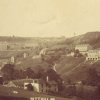The half-time system was established as part of the 1833 Factory Act that included the provision that no child had to work more than 48 hours a week. The notion of children, often initially as young as eight, dividing their time between work and school was first put forward by Robert Owen in 1818. At first the concept was seen as being quite progressive but teachers and inspectors became increasingly unhappy with the disruption to schedules and the inattention of weary pupils. After the 1870 Education Act the opposition of teachers became more vocal but it wasn’t until the 1918 Act that the system was abolished.
The Local Workforce
This delightful view of the Red Beck valley area, taken from the south, shows, in the distance, the brewery and the tannery on the Halifax side of Hipperholme cross roads. It was at the local mills, factories and quarries that many of the local pupils worked and attended school as “half timers”. Some late 19th century Lightcliffe pupils spent their mornings, often from six o’clock, working at Brear and Brown’s Brewery at Hipperholme and then in the afternoon were subjected to the rigours of the school timetable. They were 11 or 12 years old. We know that on one occasion ”mill boys in the afternoon did their dictation better than those in the morning” but this was the exception as the pupils were often too tired to study and fell asleep in class. The Revd. Frederick Watkins, a school inspector for the West Yorkshire area, noted that, “The appearance of these boys and girls is painfully interesting. They are dirty and labour soiled, in ragged clothes, with heavy eyes and worn faces. They seem to take their places in the schools as if they do not belong to them”.

